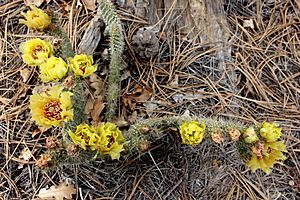Palmer Park (Colorado Springs) facts for kids
Quick facts for kids Palmer Park |
|
|---|---|

Looking from the higher elevation of Palmer Park towards downtown Colorado Springs and Cheyenne Mountain
|
|
| Lua error in Module:Location_map at line 420: attempt to index field 'wikibase' (a nil value). | |
| Location | Colorado Springs, Colorado |
| Area | 730.7 acres |
| Elevation | 6,407 feet (1,953 m) |
| Created | 1902 (land donated) |
| Operated by | City of Colorado Springs |
Palmer Park is a large park in Colorado Springs, Colorado. You can find it northeast of the city center, at 3650 Maizeland Road. This park is known for its amazing views, especially of Pikes Peak. Elevation Outdoors Magazine even called it the "Best Urban Park" in 2017. It's a great place to feel like you're in nature, even though you're close to the city!
Contents
Park History
The land where Palmer Park now sits has a long history.
Early Owners
The first known owner of this land was Matt France. In 1873, he sold the property to Henry Austin. Henry Austin used the land to raise sheep. Because of him, the area became known as Austin Bluffs.
William Palmer's Gift
In 1902, William Jackson Palmer donated 692 acres of land for the park. He was the founder of Colorado Springs. Palmer gave land for many parks in the city. He also donated land for Monument Valley Park and North Cheyenne Cañon Park. He even helped improve the roads leading to Palmer Park. Today, Palmer Park is the largest park within the Colorado Springs metro area.
Exploring Palmer Park
Palmer Park covers 730.7 acres. It has many different natural features to explore.
Geology and Views
The park has unique rock formations. You can see tall rock spires, called hoodoos, and steep cliffs. There are also wide-open fields. From many spots, you can enjoy amazing views of Pikes Peak. A special area called Seven Castles is a geological point of interest. There's also a special area for yucca plants.
Trails and Activities
Palmer Park has over 25 miles of trails. These trails are perfect for horseback riding, mountain biking, and hiking. Most trails are narrow paths, but some are wider dirt roads. The ground can be rocky and hard.
One popular trail is the Edna Mae Bennet Nature Trail. It's about 2.6 miles (4.2 km) long. This trail goes through rocky bluffs and offers views of canyons and rock formations. Other well-known trails include Templeton Trail and Yucca Flats.
The park also has many facilities for fun. You'll find a dog park where your pets can play. There are two baseball/softball fields and a football/soccer field. You can also play volleyball on one of three courts. Kids can enjoy the community playground. There are horse stables and several picnic areas too.
Plants and Animals

The park is home to many different plants and animals.
Park Flora
You can see various plants like Gambel oak trees. There are also yucca plants, piñon pine, and Ponderosa pine trees. You might even spot a pricklypear cactus in bloom.
Park Fauna
Many animals live in Palmer Park. You might see rabbits, coyotes, and foxes. Snakes, mule deer, and sometimes even bears live here. It's also a great place for bird watching! Look for hawks, ravens, towhees, magpies, pygmy nuthatches, and chickadees.
Minerals in the Park
If you're interested in rocks, you might find some cool minerals here. These include topaz, jasper, tourmaline, and quartz.



